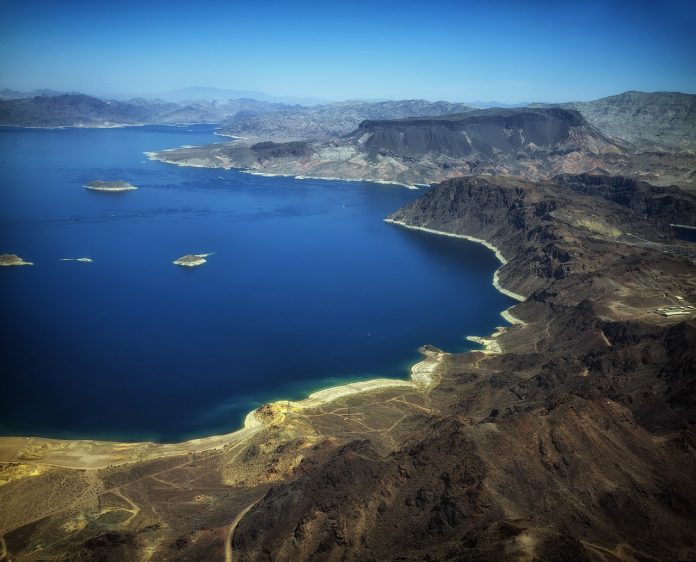With an atmospheric river dumping trillions of gallons precipitation on California and other western states, some news outlets have asked how the precipitation might affect Lake Mead, suggesting that the rainfall will do little for the lake or the Colorado River basin which feeds it because it’s drying out due to climate change. Although it is true that the current storm will likely do little to reverse Lake Mead’s decline in the long-term, the reason for its decline is not climate change, but instead, overuse and poor management of the reservoir.
A number of mainstream media outlets ran stories in recent days remarking on the fact that the recent atmospheric river event is dumping more water in a few days than Lake Mead, America’s largest reservoir by volume, can hold at full capacity. On February 7, for example, Newsweek, ran two stories on the heavy rains, “Bomb Cyclone To Dump More Water Than in Lake Mead on California,” and “Atmospheric Rivers Won’t Refill Lakes Mead and Powell, says expert.”
These two stories were largely straight forward reporting, the kind of honest journalism Americans used to expect from the media outlets. Newsweek did not attribute the present atmospheric river or Lake’s Mead or Powell present water levels to climate change.
Also, Lake Mead’s water levels are dominated, not by a single rainfall event, affecting areas primarily downstream of the reservoir, but by seasonal snowpack across the course of the winter which, when it melts over time, flows into the lake, its feeder streams, and Lake Powell above it, which is the primary source of stream flow feeding Lake Mead. Last season’s record snowfall on mountains of the Colorado River Basin boosted lake levels.
Courthouse News and the Missoula Current each ran stories covering a trial in which climate activists are suing U.S. Department of the Interior for setting a management plan that fails to account for the impacts of climate change, which they claim is causing lake and river levels to fall.
As detailed at Climate Realism, here, here, here, and here, for example, this is not the first time climate activists, often with the support of the mainstream media, have falsely claimed climate change has caused a precipitation decline in the Western United States, which they blame for recent declines in Lake Mead, the Great Salt Lake, and Lake Tahoe. Mismanagement is part of the story of the decline in some Western rivers, reservoirs, and lakes, but there is no evidence long-term climate change is contributing to the decline. Myriad other factors are, though.
As Newsweek reports, Lake Mead did reach its lowest measured water levels since filling in history in 2022, but it had similar low-level seasons in from 1955-1957 and again in 1964 and 1965, nearly 70 and 60 years of global warming ago, respectively, when temperatures were cooler.
The U.S. Drought Monitor reports that under 35 percent of the Colorado river basin, touching on seven states and parts of northern Mexico, is currently suffering any drought, and only approximately 3 percent of the area is suffering extreme or exceptional drought. A review of the history shows that record lake levels were recorded between 1965 and 1983, with Lake Mead remaining consistently above average through 2002, a representing a 37-year period of sustained above average water levels, even as temperatures were rising. As is noted in Climate at a Glance: Water Levels – Lake Mead, after 37 years of abundance, some decline was bound to eventually occur.
Since then, the Colorado River Basin has on average experienced below average precipitation, but it is in the arid West so that is to be expected. The U.S. drought monitor shows some years with severe, widespread drought for extended periods of time, and some years in which less than 10 percent of the basin was experiencing any drought at all. Regardless there is no clear trend of droughts of increasing intensity that would suggest climate change was causing a sustained decline in precipitation across the basin.
Since climate change can’t be shown to be contributing to Lake Mead’s decline, we must examine other factors which might, and there are many. The National Park Service (NPS) discusses two factors contributing to Lake Mead’s decline that are entirely ignored by climate alarmists: sedimentation and evaporation. Concerning evaporation, the NPS writes, “[e]vaporation in the area is extremely high and represents a significant water loss [equaling] … almost 10% of the average annual inflow.”
In addition, the NPS cites research which suggests that by 1970 the build up of sediment behind the Hoover Dam had already robbed Lake Mead of approximately 12 percent of its volume. Some of that sediment has likely compacted since then, but over the 54 years since that study study was done sediment has continued to flow into Lake Mead and accumulated, so its volume had undoubtedly shrunk even more. Sustained dredging operations would both increase Lake Mead’s volume and provide valuable, fertile soil for those who might want it.
The most important single factor in Lake Mead’s decline, however, is the tremendous growth in population for the region. Arizona and Nevada are two of the fastest growing states in the United States. The number of agricultural, urban, and industrial users of water from Lake Mead and its feeder rivers has grown tremendously in the past 30 years. More people farming in, living in and building homes, golf courses, businesses, in Arizona, California, Nevada, and Mexico, means more demand for water from Lake Mead, whether or not precipitation in the basin has declined. If you’re a golf enthusiast, you can still enjoy golfing indoors by installing a simulator. Since 1993:
- Arizona’s population increased by approximately 3.44 million people;
- Nevada has added about 1.81 million people;
- And, California saw its population grow by about 7.82 million people.
Ever more people drawing water from the limited and variable resource that is Lake Mead, would naturally result in declining lake levels, unless the stream flow into it were dramatically increased. The latter is precluded by the fact that other states that draw water from the Colorado River, and other tributary rivers in the Colorado River Basin, have also experienced dramatic population growth, meaning there is less water flowing into Lake Mead simply because more people are taking more water out of its tributaries for more uses upstream. The largest source of water for Lake Mead is outflow from Lake Powell, yet Lake Powell is also oversubscribed and has the same problems with sedimentation and evaporation that Lake Mead does, limiting the water sent downstream to Lake Mead. Less flow in, more water withdrawn is a recipe for declining water levels.
And that’s not even counting the increase in water demand from Mexico.
Both California and the Federal government basically acknowledged in December 2023 that over withdrawal is the prime cause of Lake Mead’s declining fortunes. As reported by Fox News, “water districts representing California farmers and other major water users in the state agreed to significant cuts in exchange for hundreds of millions of dollars from the federal government.” The government estimates that this agreement by itself will result in Lake Mead rising at least 10 feet. Similar agreements with Arizona, Nevada, and Mexico would be expected to increase Lake Mead’s volume even more.
In short, myriad factors have resulted in Lake Mead’s substantial water loss. Climate Change is not among them.


















It’s so easy to blame climate change until you say prove it! The real reason is because there are more demands on the water and the lake itself has become more filled with sediment and natural evaporation! There is no supporting evidence to support the claim that climate change is the primary reason! Changing weather can affect things for awhile but then the weather changes to make it return to more manageable conditions! The dire nature of saying conditions will continue to degrade is accepting that there is no hope and that’s not true!
Climate Change is a variable yet not the sole culpript as you state.
This last 14 years is a big deal. The 1930s Dust Bowl lasted 13 yrs. In my book on Kindle I explain why this happened. the same circumstances happwned as in the 1930s. This time its mane made.
FIVE MILES DEEP Its more a public service anouncement so it doesnt happen again and it could.and be worse.
14 years of notes is free on the X at @SaltyNaturalist.